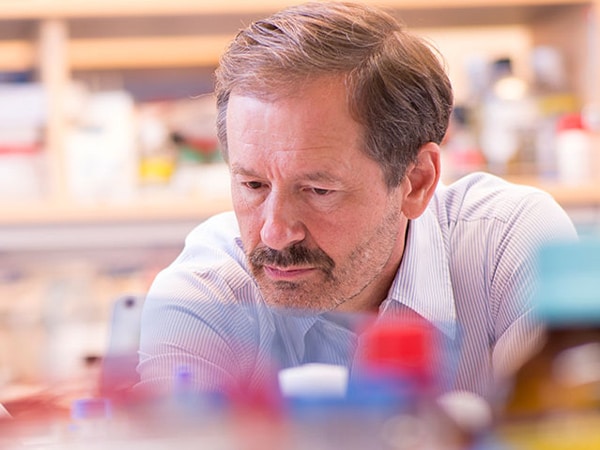Researching Liquid Biopsy in Cancer Care
Picture having a blood test instead of a colonoscopy to screen for colorectal cancer. Or having the blood sample used for a cholesterol test also serve as an early detection tool for uterine, pancreatic, or other cancers for which no screening methods currently exist.
Research presented at the virtual AACR Annual Meeting 2021 suggests those scenarios might not be far-fetched. Advances in liquid biopsy may soon augment early cancer detection, treatment selection, and patient monitoring.
“I’ve been in the cancer research space for several decades now and over the last decade I have really been excited by the possibilities of liquid biopsies and cell-free DNA technology,” said Victor E. Velculescu, MD, PhD, professor of oncology and co-director of the Cancer Genetics and Epigenetics Program at the Johns Hopkins Kimmel Cancer Center in Baltimore.
Liquid biopsies primarily involve the capture and analysis of cell-free DNA (cfDNA) shed by tumors, also called circulating tumor DNA (ctDNA), or circulating tumor cells in blood samples.
The potential to use liquid biopsy as a less-invasive means to detect or track the status of cancer and to provide more robust information about advanced tumors are among the reasons for excitement among cancer researchers, physician-scientists, and others at the AACR Annual Meeting.
“I think this is opening up new avenues for both diagnostic and therapeutic interventions which, ultimately, will help patients around the world,” said Dr. Velculescu, who serves on the steering committee of AACR Project GENIE and as chair of the AACR Publications Committee.
Liquid biopsies are currently being used to detect specific mutations in cancers that can be treated by certain molecularly targeted therapeutics. For example, late last year the U.S. Food and Drug Administration approved biomarker tests for four common cancers.
And ongoing research is assessing the value of liquid biopsies in detecting cancers early, evaluating response to treatment, detecting treatment resistance, and monitoring residual disease, among other uses.
Some liquid biopsy platforms analyze blood samples to identify specific genetic or epigenetic alterations in the DNA that are associated with certain cancer types. Others look more broadly at the patterns of fragmentation of cell-free DNA in the blood, while additional methods aim to detect tumor-associated proteins in the blood.
Research related to liquid biopsy applications was a major area of focus at the virtual AACR Annual Meeting 2021.
“The AACR is the premier organization in the world to be hosting discussions about liquid biopsies, their underlying characteristics and technologies, and their applications for cancer patients,” Dr. Velculescu said.
Here’s a summary of some of the research presented on liquid biopsies:
Screening and Early Detection. One study presented at the virtual Annual Meeting 2021 evaluated an early detection test developed by GRAIL Inc., that analyzed cell-free DNA from liquid biopsy samples to search for abnormal patterns of DNA methylation, which is a modification on DNA that can guide gene expression. Abnormal DNA methylation may be indicative of cancer. Researchers found that the test had 100 percent specificity, meaning that no false positives were found. Furthermore, the test correctly identified the site of cancer origin for all 50 different cancer types tested. Potential interfering substances, such as hemoglobin, bilirubin, and genomic DNA, among others, had no impact on cancer detection or tissue origin identification, and the test was able to detect cancer as long as the cancer-specific variant comprised at least 0.11 percent of the sample.
Another liquid biopsy early detection study was developed by Exact Sciences. Like the test described above, the test from Exact Sciences relied on detection of abnormal DNA methylation in cell-free DNA; however, unlike the above test, it also examined the presence of various cancer-associated proteins. Using a validation cohort representing six different cancer types, the researchers determined that this method correctly identified 94 percent of cases with cancer and 83 percent of cases without cancer. Sensitivity of the test varied among different cancers, ranging from 78 percent for lung cancers to 90 percent for ovarian and pancreatic cancers.
The meeting also featured a study on a third early detection test, called CancerRadar, which was developed by Early Diagnostics. This liquid biopsy test combined cell-free DNA methylation data with other features, including cell-free DNA fragment size, copy number variations, and microbial composition. CancerRadar correctly identified 89.1 percent of cancer cases, including 85.7 percent of early-stage cancers, in a validation cohort. The test correctly identified 97 percent of cases without cancer. Furthermore, CancerRadar accurately identified the cancer’s tissue origin 91.5 percent of the time across all tumor stages and 89.1 percent of the time for early-stage cancers.
Although additional validation studies are required, these three studies suggest that liquid biopsy tests may prove to be powerful tools for screening and early detection.
Treatment Selection for a Targeted Therapy. In another study presented at the AACR Annual Meeting 2021, researchers evaluated a novel liquid biopsy strategy to identify patients whose lung cancers have mutations in the EGFR gene and who may, therefore, benefit from certain targeted cancer therapies. Since previous studies found that liquid biopsy tests performed with cell-free DNA from plasma samples had low sensitivity, the researchers of this study instead evaluated DNA from bronchoalveolar lavage fluid (BALF) of patients with advanced non-small cell lung cancers. This method was quicker than tissue biopsy, correctly identified 97.8 percent of cancer cases and 96.9 percent of non-cancer cases, and it showed high levels of agreement (97.7 percent) with traditional tissue biopsy. This study demonstrates how liquid biopsy may facilitate treatment selection for certain targeted therapies.
Treatment Monitoring and Response. In another study, researchers examined the utility of liquid biopsy to identify pathologic complete responses after neoadjuvant chemotherapy in patients with breast cancer. Typically, such responses are assessed by magnetic resonance imaging (MRI) and lymph node biopsies, but these methods have several limitations, including the suboptimal accuracy associated with MRI and the invasive nature of lymph node biopsies. Here, researchers examined cell-free DNA fragment sizes to assess treatment responses, as cancer cell death has been associated with DNA fragments of varying sizes. They found that cell-free DNA accurately predicted 81.6 percent of pathologic complete responses, which was higher than the 77.1 percent accuracy observed with MRI. Accuracy was even higher when liquid biopsy was combined with MRI. These results highlight another potential application of liquid biopsy in the treatment and management of cancer.
Early-stage Disease: Screening and Early Detection
There is a lot of attention on the potential of liquid biopsies for screening and early detection of cancer. Experts agree that giving people the option to have a simple blood test could be an important way to increase adherence to screening.
Much of the excitement revolves around the promise of using liquid biopsies to detect cancers for which no screening methods currently exist. Examples include ovarian cancer, pancreatic cancer, gallbladder cancer, gastric cancer, uterine cancer, and other malignancies.
Experts point out that while such research is very promising, additional research and clinical trials are needed to access the efficacy and benefits of liquid biopsies before such tests can be used in the clinical setting. Questions center on whether using liquid biopsies to identify certain cancers at very early stages will ultimately reduce the number of deaths from those diseases.
Localized Disease: Risk of Recurrence
Another area in which liquid biopsy is currently being studied focuses on early-stage cancers in patients with localized disease. According to Dr. Velculescu, the technology is being studied within the context of surgical resection to determine if it can answer questions after surgery.
“Does the patient still have localized disease? Does he or she still have what’s called residual disease that hasn’t been fully removed by the surgery? The question is whether additional therapy at that time point could help the patient,” he said.
Metastatic Disease: Treatment Selection for Targeted Therapy
The U.S. Food and Drug Administration (FDA) approvals in 2020 of the Guardant 360 CDx and FoundationOne Liquid CDx are currently the only FDA approvals of liquid biopsy tests that use next-generation sequencing technology. These two tests are approved for use as companion diagnostics to identify patients who might be candidates for specific molecularly targeted therapy.
In clinical practice, liquid biopsies are most often used to evaluate patients with advanced cancer to determine whether they might be candidates for targeted treatments or to better understand their prognosis, Bert Vogelstein, MD, FAACR, a researcher and cancer geneticist at the Johns Hopkins Kimmel Cancer Center in Baltimore, told Cancer Today magazine.
“That’s because patients with cancer that has spread to another part of the body are more likely to have genetic alterations present in their bloodstream,” Vogelstein said.
However, it’s unlikely that liquid biopsy will be totally edging out traditional tissue biopsies any time soon. Tissue biopsies still remain the gold standard for analyzing the extent and nature of cancer mainly because liquid biopsies can miss small cancers that may not shed detectable amounts of genetic material into the blood stream.
Read “Are Liquid Biopsies Ready for the Clinic?” in Cancer Today here.
Still, liquid biopsies have several advantages, including a faster turnaround time for results and the ability to access hard-to-reach tumors.
Razelle Kurzrock, MD, director of the Center for Personalized Cancer Therapy at the Moores Cancer Center at the University of California, San Diego said, “it’s much easier to get a blood sample than tissue” in the article, which also appeared on the AACR’s Cancer Research Catalyst blog.
Treatment Monitoring and Response
Another benefit of using liquid biopsy technology in more advanced cancers stems from the opportunity to use a biomarker approach that can potentially inform clinicians about a patient’s response to treatment on a more “real time” basis versus a specific “snapshot in time” of conventional imaging techniques.
“We’ve seen sometimes that new resistant alterations emerge months before we see a change on a CT scan,” Dr. Kurzrock said.
Additional studies and clinical trials are needed to further evaluate using liquid biopsies to monitor treatment and response to treatment.
Refractory Disease: Treatment Resistance
Liquid biopsies also open the door to other possibilities, including the ability to do a series of blood draws over time to pick up on emerging resistance to a therapeutic.
“When patients progress, it’s obviously helpful to understand what the multitude of changes are within an individual cancer in order to decide what therapy to use next,” said Dr. Velculescu.
He said that using liquid biopsies as a tool to reassess the management plan of a patient is a very useful application—one that is already in use clinically.
Return to AACR Stories Home
